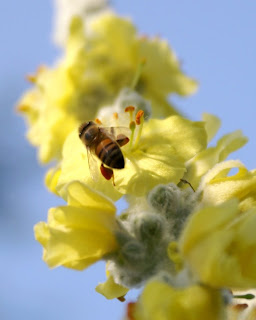
Verbascum bombyciferu
 m, known as Silver mullein and often sold as Arctic Summer turns out to be well worth giving a try. I picked up this plant a year ago at the Target garden center near me. This plant is variously described as a biennial or perennial; I guess time will tell now that it is blooming. The first-to-emerge flower spike is now about 8 feet tall, and being followed by more spikes as time goes on. On a recent visit to San Francisco I saw cut spikes for sale at a flower stall and was surpr
m, known as Silver mullein and often sold as Arctic Summer turns out to be well worth giving a try. I picked up this plant a year ago at the Target garden center near me. This plant is variously described as a biennial or perennial; I guess time will tell now that it is blooming. The first-to-emerge flower spike is now about 8 feet tall, and being followed by more spikes as time goes on. On a recent visit to San Francisco I saw cut spikes for sale at a flower stall and was surpr ised since, hey, I never was aware of verbascum flowers before. Now that I am, I think it would be outstanding to have enough garden space for a dense planting of these.
ised since, hey, I never was aware of verbascum flowers before. Now that I am, I think it would be outstanding to have enough garden space for a dense planting of these.Lots of honeybees visit the blossoms and you can see by the color of pollen on the bees' legs it seems to be the pollen from the verbascum.
Suspended between the tallest flower spikes is a great spot for the web and shelter of a labyrinth spider, Metepeira sp. Hopef
 ully you can see from the photo the typical labyrinth spider web arrangement: the orb web is similar but maybe smaller than that of other orb web weavers and how the little spider shelter or retreat is a mess of silk and plant debris positioned behind and toward the bottom half of the orb web.
ully you can see from the photo the typical labyrinth spider web arrangement: the orb web is similar but maybe smaller than that of other orb web weavers and how the little spider shelter or retreat is a mess of silk and plant debris positioned behind and toward the bottom half of the orb web.Before flowering, the verbascum is a 3 foot or so wide rosette of large silvery leaves. As the plant blooms, the rosette enlongates into a pyramid shaped spire of leaves and multiple inflorescences, reaching 8 feet and growing.



4 comments:
I always love your photos & info. I think you are right about a mass planting. Love the soft yellow blooms.
Very pretty! Love the spiderweb!
Interestingly, this plant is invasive in Oregon, where it's colonized the roadsides. But it seems to be fine in CA, and it sure is pretty.
Given the heated discussion on invasive garden plants over at Garden Rant today, I thought I would check on V. bomby's I.Q. (invasiveness quotient). So far I found it has a few cousins (common mullein, verbascum thapsus in particular) that are listed as invasive in the west. I think it's important to research potential problem plants, avoid what's bad in your region, and be aware of emerging problems.
My plant ID teacher first told me about this plant. Apparently, it's popular in the South. Since mulleins add vertical interest in the small garden, I decided to try it and really enjoyed the way dew and rain played on those felted leaves. It was very much a biennial for me, so enjoy it now! :)
Post a Comment